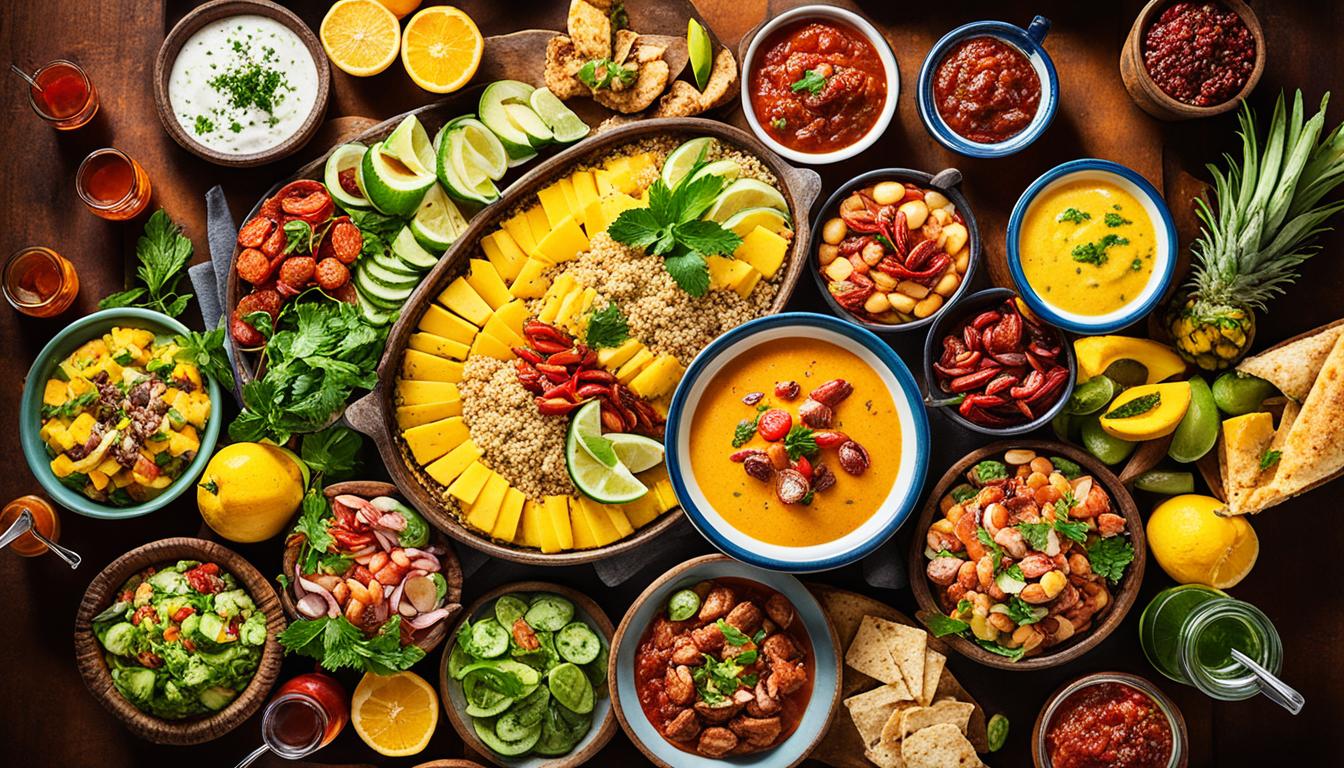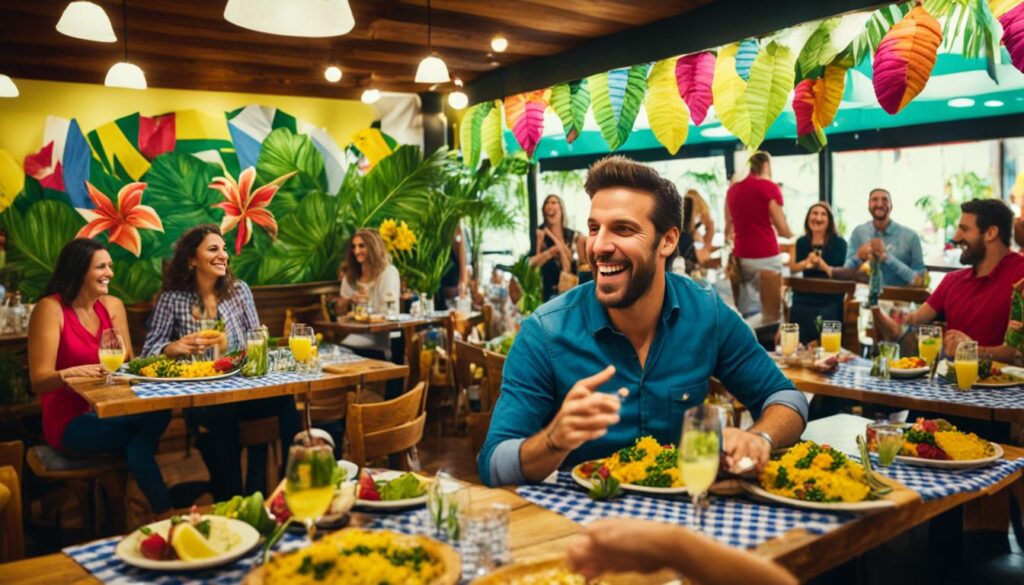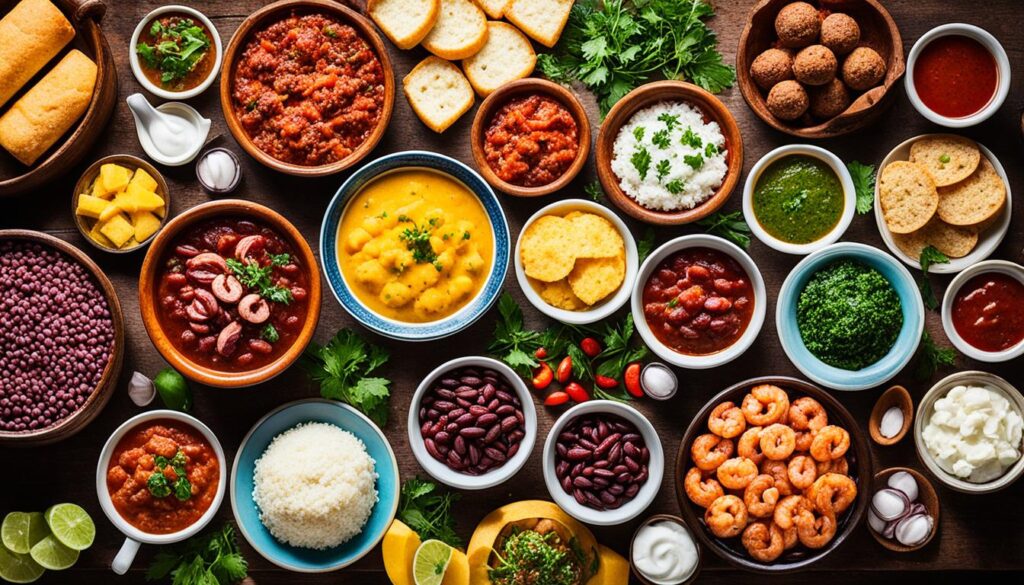
Embark on a culinary journey through the vibrant flavors and rich traditions of Brazilian cuisine. From traditional dishes to popular beverages, dining in Brazil offers a unique and delightful experience for food enthusiasts. Immerse yourself in the diverse culinary heritage of this vast country and discover the gastronomic wonders that await you.
With influences from indigenous cultures, European settlers, Africans, Asians, and Middle-Easterners, Brazilian cuisine is a fusion of flavors and techniques. Each region boasts its own distinctive dishes, reflecting the historical and cultural diversity that defines Brazil.
Key Takeaways:
- Brazilian cuisine is a blend of indigenous, European, African, Asian, and Middle-Eastern influences.
- Each region of Brazil has its own unique traditional dishes and gastronomic specialties.
- From savory foods like feijoada and coxinhas to sweet treats like brigadeiros, Brazilian cuisine offers a wide variety of flavors.
- Popular Brazilian beverages include acai, caipirinha, guarana, and coconut water.
- Exploring the food culture in Brazil is a must to fully appreciate the country’s culinary heritage.
Overview of Traditional Brazilian Meals
Brazilian cuisine is a vibrant tapestry of flavors influenced by a rich cultural heritage and the country’s vast geographical diversity. Traditional Brazilian meals incorporate a wide range of ingredients, reflecting the country’s agricultural abundance and multicultural history.
When it comes to traditional Brazilian meals, the key lies in the unique combination of ingredients that create a harmonious blend of flavors and textures. Let’s explore the typical ingredients that form the basis of Brazilian cooking:
- Nuts: Cashews and Brazil nuts are commonly used in Brazilian cuisine, adding richness and crunch to various dishes.
- Vegetables: Cassava, a starchy root vegetable, and okra, a versatile green vegetable, are staples in Brazilian recipes.
- Tropical Fruits: Brazil’s tropical climate allows for the cultivation of a wide variety of fruits, including pineapple, mango, passion fruit, and guava, which add a refreshing and vibrant element to many dishes.
- Meats: Seafood, poultry, pork, and beef feature prominently in traditional Brazilian meals, reflecting the country’s diverse culinary traditions.
- Dairy Products: Cow’s milk and typical Brazilian cheeses, such as queijo minas and queijo coalho, are commonly used in Brazilian cooking and contribute to the richness of many dishes.
- Legumes: Beans, such as black beans and feijão tropeiro, are a staple in Brazilian cuisine, providing a good source of protein and fiber.
- Grains: Rice and cornmeal are essential grains used in Brazilian cooking, serving as the foundation for meals like feijoada and farofa.
- Palm Oil: Widely used in Brazilian cooking, palm oil, known as dendê, imparts a unique flavor and vibrant color to dishes like moqueca.
These ingredients serve as building blocks for a myriad of traditional Brazilian dishes, each possessing its own regional variations and cultural significance.
Traditional Brazilian Savory Foods
When it comes to traditional Brazilian cuisine, the savory dishes are a true delight. From mouthwatering appetizers to hearty dinners, Brazilian savory foods offer a burst of flavor that will satisfy your taste buds. Let’s explore some of the most popular traditional Brazilian savory foods, including appetizers, dinners, and everything in between.
Brazilian Appetizers
When it comes to appetizers, Brazil offers a variety of delicious options. One popular choice is bolinhos de bacalhau, also known as codfish balls. These bite-sized treats are made with salted codfish, potatoes, onions, and parsley. They are deep-fried to perfection, resulting in a crispy exterior and a soft and flavorful center.
Another beloved Brazilian appetizer is coxinhas, which are shredded chicken croquettes. These golden-fried delights are made with a dough filled with seasoned shredded chicken, shaped into a teardrop shape, breaded, and then fried until crispy. They are usually served with a side of spicy dipping sauce, adding an extra kick to every bite.
| Savory Appetizer | Description |
|---|---|
| Bolinhos de Bacalhau | Codfish balls made with salted codfish, potatoes, onions, and parsley, deep-fried to perfection. |
| Coxinhas | Shredded chicken croquettes with a crispy exterior and a soft, flavorful center, served with a side of spicy dipping sauce. |
Brazilian Dinners
When it comes to hearty dinners, Brazilian cuisine has some iconic dishes that are sure to satisfy even the most discerning palate.
One such dish is feijoada, a classic bean stew with pork. This hearty and flavorful dish consists of black beans slow-cooked with various cuts of pork, such as sausages, bacon, and pork ribs. It’s typically served with rice, collard greens, farofa (toasted cassava flour), and orange slices. Feijoada is often enjoyed on special occasions and gatherings.
Another mouthwatering dinner option is moqueca, a delicious seafood stew. This dish originated in the Northeast region of Brazil and is made with a variety of fresh seafood, including fish, shrimp, and squid, cooked in a flavorful tomato and coconut milk base. It’s typically seasoned with aromatic herbs and spices, such as cilantro, garlic, and palm oil. Moqueca is usually served with rice and farofa, creating a complete and satisfying meal.
| Savory Dinner | Description |
|---|---|
| Feijoada | Classic bean stew with pork, slow-cooked black beans with various cuts of pork, served with rice, collard greens, farofa, and orange slices. |
| Moqueca | Seafood stew made with fish, shrimp, and squid, cooked in a tomato and coconut milk base, seasoned with aromatic herbs and spices, served with rice and farofa. |
Experience the Flavors of Brazil
These traditional Brazilian savory foods are just a glimpse into the rich and diverse culinary culture of Brazil. From the crispy and flavorful appetizers to the hearty and comforting dinners, these dishes showcase the unique blend of influences that make Brazilian cuisine so extraordinary.
So, whether you’re in Brazil or trying out authentic Brazilian recipes at home, be sure to savor these traditional savory treats. Your taste buds will thank you!
Traditional Brazilian Sweets
Indulge your sweet tooth with a taste of traditional Brazilian sweets. These delectable desserts are beloved for their rich flavors and mouthwatering textures. Whether you’re exploring the bustling streets of Brazil or attending a festive event, you’ll find these traditional sweets to be a delightful treat.
Brigadeiros
One of the most popular Brazilian desserts is brigadeiros, chocolate truffles made with condensed milk, cocoa powder, butter, and chocolate sprinkles. These bite-sized treats are often served at birthday parties, celebrations, and gatherings. The combination of creamy chocolate and crunchy sprinkles makes brigadeiros an irresistible indulgence.
Canjica
Canjica is a traditional sweet corn pudding often enjoyed during religious festivities, particularly in the month of June. Made from boiled corn kernels, milk, sugar, and spices such as cinnamon and cloves, canjica has a creamy and comforting texture. Topped with coconut flakes, it is a comforting and flavorful dessert that highlights the abundance of corn in Brazilian cuisine.
Quindim
Quindim is a luscious coconut flan that originated in northeastern Brazil. It is made with egg yolks, sugar, grated coconut, and sometimes a splash of vanilla. The dessert has a custard-like texture and a golden color due to the addition of egg yolks. Quindim is often served chilled and garnished with toasted coconut flakes or a drizzle of caramel sauce.
These traditional Brazilian sweets are just a small sampling of the many delightful desserts you’ll encounter in Brazil. Each region offers its own unique sweet specialties that reflect the local ingredients and cultural influences. From the chocolatey indulgence of brigadeiros to the comforting flavors of canjica and the tropical delight of quindim, Brazilian desserts are sure to leave a lasting impression.
Traditional Brazilian Drinks
When it comes to traditional Brazilian drinks, there are a few iconic choices that you simply can’t miss. From refreshing fruit concoctions to the renowned national cocktail, Brazil offers a diverse range of beverages that perfectly complement its vibrant cuisine.
Acai
One of the most beloved traditional Brazilian drinks is acai. Derived from the superfood berry native to the Amazon rainforest, acai is often enjoyed as a sorbet or a revitalizing smoothie. Known for its deep purple hue and rich flavor, acai is a popular choice among locals and visitors alike.
Caipirinha
The caipirinha holds the title of Brazil’s national cocktail and is a true symbol of the country’s vibrant culture. Made with cachaça, a sugarcane spirit, fresh lime, and sugar, this refreshing drink is a must-try for any traveler seeking an authentic taste of Brazil. The combination of citrus and sweetness creates a delightful and invigorating flavor experience.
Other Popular Brazilian Beverages
Aside from acai and caipirinha, there are several other traditional Brazilian drinks worth exploring. Guarana, a carbonated soft drink made from the guarana fruit, offers a unique and energizing flavor experience. And for those seeking hydration in the tropical climate, coconut water provides a refreshing and naturally sweet option.
Whether you’re sipping on acai to beat the heat or raising a glass of caipirinha to celebrate, traditional Brazilian drinks are the perfect accompaniment to the flavors and spirit of this vibrant country.
Regional Brazilian Foods
Brazilian cuisine is a vibrant tapestry of flavors, shaped by the country’s diverse geographical regions. Each region boasts its own unique culinary traditions and specialties, highlighting the rich cultural heritage of Brazil. From the Amazon rainforest in the North to the southernmost state of Rio Grande do Sul, the regional foods of Brazil offer a delightful exploration of flavors.
The North Region
In the North region, the cuisine revolves around the abundant resources of the Amazon rainforest and the proximity to the Atlantic Ocean. The region is known for its heavy use of manioc (cassava) and freshwater fish, creating dishes that are rich in flavor and unique to the region.
The Northeast Region
The Northeast region showcases a blend of African, Native, and Portuguese influences in its cuisine. Popular dishes include acarajé, which are black-eyed bean fritters stuffed with shrimp, and moqueca baiana, a flavorful Bahian seafood stew.
The Mid-West Region
The Mid-West region of Brazil features a diverse range of dishes influenced by the Pantanal wetlands and traditional indigenous cultures. Rice with pequi, a fruit with a unique aroma and flavor, is commonly enjoyed in this region. Another staple is galinhada, a dish made with chicken and rice.
The Southeast Region
The Southeast region is a melting pot of culinary influences, including Portuguese, Italian, Japanese, Lebanese, and African. This diverse mix is reflected in dishes like feijoada, a hearty black bean stew with pork, and pão de queijo, popular cheese bread rolls.
The Southern Region
The Southern region of Brazil is heavily influenced by European immigrants, particularly from Italy and Germany. It is known for dishes like churrasco, a mouthwatering grilled meat feast, and chimarrão, an herbal tea traditionally sipped from a gourd.
Exploring the regional foods of Brazil allows you to embark on a gastronomic journey through the country’s culinary heritage. From the exotic flavors of the North to the hearty dishes of the South, each region offers a unique and delicious experience.
Continue reading to discover more about the authentic Brazilian meals you can enjoy in restaurants across the country.
Authentic Brazilian Meals in Restaurants
When it comes to experiencing the true flavors of Brazil, dining out in the country’s restaurants is a must. From bustling buffets to refined eateries, Brazil offers a range of options where you can savor authentic Brazilian meals.
In commercial areas, you’ll often find buffets that showcase regional dishes from all over Brazil. These buffets allow you to explore a variety of flavors and culinary traditions in one place. From the rich feijoada of the Southeast to the flavorful moqueca of the Northeast, these buffets offer a true gastronomic journey through the country.
If you prefer a more upscale dining experience, there are plenty of restaurants that offer à la carte menus featuring traditional Brazilian dishes. These restaurants focus on highlighting the unique flavors and ingredients of Brazilian cuisine, allowing you to indulge in dishes that are prepared with authenticity and care.
In addition to traditional restaurants, Brazil is also known for its rodizio-style dining. This style of dining originated in Brazil and is popular in steakhouses, pizzerias, and even sushi places. In a rodizio-style restaurant, you can enjoy a variety of all-you-can-eat grilled meats brought directly to your table. It’s a feast for the senses and a beloved Brazilian dining experience.
So whether you’re looking to explore regional specialties, savor refined Brazilian cuisine, or indulge in a rodizio-style feast, dining out in Brazil is sure to tantalize your taste buds and leave you with lasting culinary memories.

| Restaurant Type | Description |
|---|---|
| Buffets | Commercial areas offer buffets with regional dishes, allowing you to taste a variety of authentic Brazilian cuisine in one place. |
| À la carte Restaurants | Refined restaurants and mall eateries offer à la carte options featuring traditional Brazilian dishes prepared with authenticity and care. |
| Rodizio-style Dining | Steakhouses, pizzerias, and sushi places offer rodizio-style dining, where you can indulge in all-you-can-eat grilled meats. |
Brazilian Daily Meals & Staples
Brazilians have a unique culinary culture that revolves around the enjoyment of food and the sharing of meals with family and friends. Daily meals in Brazil typically consist of a variety of flavors and dishes, showcasing the diversity of Brazilian cuisine.
Breakfast: The first meal of the day varies by region in Brazil. In the North, breakfast tends to be heartier, often featuring dishes like tapioca pancakes filled with cheese or meat, accompanied by tropical fruits such as acai or cupuaçu. In the Southeast, breakfast is lighter and may include bread, ham, cheese, and coffee.
Morning Snack: Brazilians enjoy a small snack in the mid-morning, known as a “lanche” or “café da manhã.” This may consist of a sandwich, sliced fruits, or a piece of cake.
Lunch: Lunch is the main meal of the day in Brazil and typically served between 12 pm and 2 pm. It is a substantial and hearty meal that often includes rice, beans, meat (such as beef, chicken, pork, or fish), vegetables, and salad. Feijoada, a traditional black bean stew with pork, is a popular dish often enjoyed on weekends.
Afternoon Snack: In the late afternoon, Brazilians indulge in another small snack, known as “lanche da tarde.” This can include pastries, sandwiches, or even a slice of cake.
Dinner: Dinner in Brazil is usually a lighter meal compared to lunch. It often consists of soup, grilled meat or fish, salads, or leftovers from lunch. It is common to see families come together for dinner and enjoy a leisurely meal.
Late Snack: Brazilians have a habit of having a small snack before bed, known as “ceia.” This can be a piece of fruit, a yogurt, or a slice of bread.
Throughout the day, Brazilians also enjoy various snacks and street foods. Some popular options include coxinha, which are deep-fried chicken fritters, and pastel de carne, fried or baked empanadas filled with ground beef.
| Mealtime | Typical Dishes |
|---|---|
| Breakfast | Tapioca pancakes, tropical fruits |
| Morning Snack | Sandwiches, sliced fruits, cake |
| Lunch | Rice, beans, meat, vegetables, salad |
| Afternoon Snack | Pastries, sandwiches, cake |
| Dinner | Soup, grilled meat or fish, salads |
| Late Snack | Fruit, yogurt, bread |
These meals and snacks are an integral part of Brazilian culture, reflecting the importance of food and the joy of sharing meals with loved ones. Whether savoring a savory feijoada or indulging in a sweet brigadeiro for dessert, experiencing the daily meals and staples of Brazil is a delightful culinary adventure.
Conclusion
Brazilian cuisine is a vibrant tapestry of flavors, reflecting the rich cultural heritage and regional influences of the country. From traditional dishes to popular desserts and drinks, the gastronomy of Brazil offers a diverse and exciting culinary experience that will satisfy any food lover’s palate.
Exploring Brazilian cuisine allows you to embark on a gastronomic journey through the different regions, each with its unique ingredients and cooking techniques. Whether you indulge in a hearty feijoada, savor the flavors of a delicious moqueca, or satisfy your sweet tooth with brigadeiros, the traditional dishes of Brazil showcase the country’s culinary diversity.
When dining in Brazil, be sure to try authentic Brazilian restaurants that offer a true taste of the country’s gastronomy. These restaurants provide an opportunity to immerse yourself in the local food culture and experience the flavors and aromas that make Brazilian cuisine so unique.
From the bustling streets of Rio de Janeiro to the tranquil coastal towns of Bahia, the culinary delights of Brazil are waiting to be discovered. Don’t miss the chance to try traditional Brazilian food and drinks during your visit, and allow yourself to be captivated by the rich flavors and incredible variety of this remarkable cuisine.
| Popular Brazilian Dishes | Traditional Brazilian Drinks |
|---|---|
| Feijoada | Caipirinha |
| Moqueca | Acai |
| Coxinhas | Guarana |
| Brigadeiros | Coconut Water |
90+ Traditional Brazilian Foods That Are Mouthwatering
Looking to explore the vibrant and diverse flavors of Brazilian cuisine? Look no further! We have compiled a comprehensive list of over 90 traditional Brazilian foods that are guaranteed to make your taste buds dance with delight. From appetizers to dinners, desserts to drinks, this list covers it all.
Each item on the list is accompanied by a complete recipe, allowing you to recreate these authentic Brazilian dishes right in your own kitchen. Whether you’re a seasoned chef or a beginner, these recipes provide clear instructions and ingredients to help you master the art of Brazilian cooking.
Here’s a small taste of what you’ll find on the list:
Pão de Queijo – These delicious cheese bread rolls are a staple in Brazilian cuisine. Made with cassava flour and cheese, they are soft and chewy on the inside with a crispy crust.
But that’s just the beginning! The list includes a wide variety of savory and sweet dishes that showcase the rich flavors and cultural diversity of Brazil. Whether you’re craving feijoada, a hearty black bean stew with pork, or brigadeiros, delectable chocolate truffles, you’ll find it all on our list.
Ready to embark on a culinary journey through Brazil? Click here to access the full list of traditional Brazilian foods and start exploring the vibrant flavors of this incredible cuisine.
Traditional Brazilian Food FAQs
Are you curious about traditional Brazilian food? Here are answers to some commonly asked questions about popular Brazilian dishes:
1. What is feijoada?
Feijoada is a hearty bean stew that is often considered Brazil’s national dish. It typically consists of black beans cooked with various cuts of pork, such as bacon, sausage, and ribs. This flavorful dish is traditionally served with rice, collard greens, and farofa (toasted cassava flour).
2. What is moqueca?
Moqueca is a flavorful seafood stew made with fish, shrimp, or other seafood, cooked in a fragrant base of coconut milk, onions, tomatoes, and peppers. It is commonly served with rice and accompanies by farofa and pirão (a thick fish broth).
3. What are brigadeiros?
Brigadeiros are delicious chocolate truffles that are popular in Brazil. Made with condensed milk, cocoa powder, butter, and chocolate sprinkles, these bite-sized treats are a must-try for anyone with a sweet tooth.
4. How do traditional Brazilian dishes vary by region?
Traditional Brazilian dishes vary across the different regions of the country. In the North, you will find dishes that feature ingredients like manioc (cassava) and freshwater fish. The Northeast region is known for its African, Native, and Portuguese influences, resulting in unique dishes like acarajé and moqueca baiana. The Mid-West offers dishes like rice with pequi and galinhada. The Southeast region showcases a blend of Portuguese, Italian, Japanese, Lebanese, and African influences. The Southern region is influenced by European cuisine, with dishes like churrasco and chimarrão.
5. Can you provide a visual timeline of the cultural significance of traditional Brazilian food?
| Time Period | Significance |
|---|---|
| Indigenous Influences | Native Brazilian tribes contributed to the use of ingredients like manioc and other root vegetables, as well as methods like grilling and smoking meats. |
| Colonial Era | European settlers introduced ingredients such as rice, wheat, and livestock, as well as techniques like baking and dairy production. |
| African Influence | Enslaved Africans brought their culinary traditions, contributing to dishes like feijoada and acarajé. |
| Modern Influence | Immigrants from various countries brought their culinary traditions, resulting in a diverse and vibrant food culture in Brazil. |
6. What are some other popular Brazilian foods?
Alongside feijoada, moqueca, and brigadeiros, Brazil is known for other delicious dishes such as:
- Pão de queijo: Cheese bread made with cassava flour.
- Coxinha: Deep-fried chicken fritters filled with shredded chicken.
- Açaí: A sweet and nutty berry served as a sorbet or smoothie.
- Caipirinha: Brazil’s national cocktail made with cachaça, lime, and sugar.
- Pastel: Fried or baked empanadas filled with various ingredients like cheese, meat, or vegetables.
Now that you have some answers to your traditional Brazilian food FAQs, you’re ready to explore the flavors and cultural significance of Brazil’s culinary delights!

The Best of Brazilian Cuisine
When it comes to experiencing the flavors of Brazil, there are certain dishes that you simply cannot miss. From savory appetizers to delectable desserts, Brazilian cuisine has it all. Here are some of the best traditional Brazilian dishes that you must try during your visit to Brazil:
Savory Delights
- Coxinhas: These savory chicken croquettes are a popular street food in Brazil. They are made with shredded chicken, shaped into a teardrop, coated with breadcrumbs, and deep-fried to perfection.
- Feijoada: Considered the national dish of Brazil, feijoada is a flavorful black bean stew with a variety of meats, such as pork, beef, and sausage. It is typically served with rice, collard greens, and farofa (toasted cassava flour).
- Moqueca: This delicious seafood stew is a specialty of the Northeast region of Brazil. Made with fresh fish, shrimp, or a combination of both, it is cooked in a clay pot with coconut milk, dendê oil (palm oil), tomatoes, peppers, and onions.
Sweet Temptations
- Brigadeiros: These chocolate truffles are a true indulgence. Made with condensed milk, cocoa powder, butter, and chocolate sprinkles, brigadeiros are a staple at birthday parties and celebrations in Brazil.
- Acai Bowl: Acai is a superfood berry native to the Amazon rainforest. In Brazil, it is commonly enjoyed as a refreshing and nutritious bowl topped with granola, bananas, and other fruits.
- Quindim: This traditional Brazilian dessert is a sweet, rich, and creamy coconut flan. Made with egg yolks, sugar, coconut milk, and shredded coconut, quindim is a delightful treat for those with a sweet tooth.
These dishes represent the essence of Brazilian cuisine and showcase the diverse flavors and influences found throughout the country. Whether you prefer savory or sweet, there is something for everyone to enjoy in Brazil.
Now that you know about the best of Brazilian cuisine, it’s time to embark on a gastronomic adventure and savor the authentic and mouthwatering flavors that Brazil has to offer.
Brazilian Street Food
Brazilian street food is a vibrant and delicious part of the culinary landscape in Brazil. It offers a wide array of mouthwatering snacks that reflect the diverse flavors and cultural heritage of the country. Whether you’re strolling through the bustling streets of Rio de Janeiro or exploring the local markets in Salvador, you’re bound to encounter street vendors with enticing treats that will tantalize your taste buds.
One of the most popular street snacks in Brazil is pão de queijo, which translates to “cheese bread.” These small, cheesy bread balls are made with cassava flour, cheese, eggs, and oil, resulting in a crispy exterior and a soft, gooey center. They are incredibly addictive and pair perfectly with a strong cup of Brazilian coffee.
Another beloved street food in Brazil is empadas, savory pastries filled with various ingredients such as chicken, cheese, beef, or shrimp. These bite-sized treats are encased in a flaky pastry crust and make for a convenient on-the-go snack.
For a taste of Afro-Brazilian cuisine, be sure to try acarajé. Originating from the state of Bahia, acarajé consists of deep-fried balls of black-eyed pea dough, stuffed with a flavorful mixture of shrimp, onions, tomatoes, and spices. It is commonly served with a hot sauce called vatapá and can be quite spicy, making it a favorite among those who enjoy a kick of heat in their street food adventures.
“Brazilian street food is a delightful tapestry of flavors, textures, and aromas that reflects the country’s vibrant culinary heritage. From the cheesy indulgence of pão de queijo to the zesty explosion of flavors in acarajé, every bite offers a tantalizing glimpse into the rich and diverse street food culture of Brazil.”
Popular Brazilian Street Food
| Street Snack | Description |
|---|---|
| Pão de Queijo | Small cheese bread balls made with cassava flour and cheese, with a crispy exterior and a soft, gooey center. |
| Empadas | Savory pastries filled with ingredients such as chicken, cheese, beef, or shrimp, encased in a flaky pastry crust. |
| Acarajé | Deep-fried balls of black-eyed pea dough stuffed with a flavorful mixture of shrimp, onions, tomatoes, and spices, typically served with a hot sauce called vatapá. |
Exploring the world of Brazilian street food is not only a delicious journey but also an opportunity to immerse yourself in the vibrant local culture and connect with the friendly street vendors who take pride in their culinary creations. So, don’t miss the chance to savor these popular street snacks in Brazil and experience the unique flavors that make Brazilian street food a true gastronomic adventure.
Exploring Brazil’s Food Culture
Immerse yourself in the vibrant food culture of Brazil and discover the rich culinary traditions that make this country a gastronomic paradise. From regional specialties to the cultural significance of food in daily life, Brazil offers a unique and diverse dining experience that will satisfy every food lover’s palate.
One of the defining aspects of Brazilian gastronomy is its fusion of indigenous, European, African, Asian, and Middle Eastern influences. This melting pot of cultures has shaped the country’s diverse food culture, resulting in a wide array of flavors, ingredients, and cooking techniques.
Each region in Brazil has its own culinary identity, with distinctive dishes that showcase the local ingredients and cultural traditions. Whether you’re indulging in feijoada, a hearty bean stew with pork, in the Southeast, or savoring the flavors of moqueca, a delicious seafood stew, in the Northeast, you’ll be treated to a culinary journey that highlights the unique flavors and ingredients of each region.
Food holds a special place in Brazilian daily life, serving as a way to connect with family and friends, celebrate special occasions, and showcase the country’s cultural heritage. From vibrant street food markets to bustling restaurants, the traditions and rituals associated with Brazilian gastronomy are deeply ingrained in the fabric of society.







